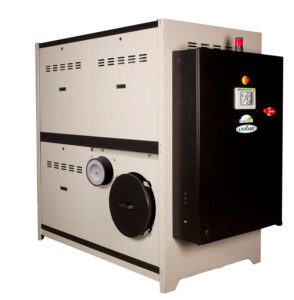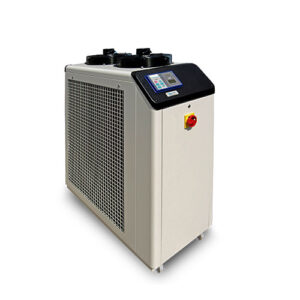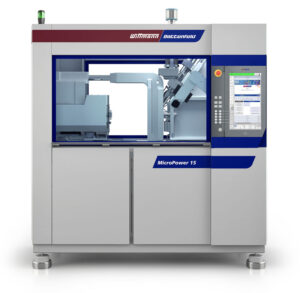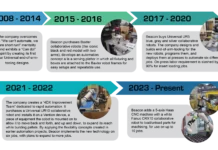by Liz Stevens, contributing writer, Plastics Business
 For plastics processors and the companies that provide auxiliary equipment to them, 2020 was the year that was… was a challenge, was an opportunity, was a reminder that we work better together and was definitely not business as usual. This article takes a look at how new technology has helped auxiliary equipment suppliers to meet the challenges, seize the opportunities, reach out to help their customers in a time of need and forge ahead, despite the altered business landscape.
For plastics processors and the companies that provide auxiliary equipment to them, 2020 was the year that was… was a challenge, was an opportunity, was a reminder that we work better together and was definitely not business as usual. This article takes a look at how new technology has helped auxiliary equipment suppliers to meet the challenges, seize the opportunities, reach out to help their customers in a time of need and forge ahead, despite the altered business landscape.
Responding to COVID-19
COVID-19 was the lens through which plastics processors and auxiliary equipment suppliers, like everyone else, saw the world in 2020. While many industries were sidelined by the pandemic, the need for personal protective equipment, testing gear and medical products kept the plastics industry working steadily, if not working overtime. To meet the needs of customers as they responded rapidly to changing market conditions, industry suppliers such as The Conair Group, Frigel North America and Wittmann Battenfeld had to react quickly themselves.
The Conair Group of Cranberry Township, Pennsylvania, provides blending, conveying, drying, extrusion, heat transfer, material storage and size reduction equipment for the plastics industry. As Sam Rajkovich, vice president sales and marketing, sees it, COVID-19’s most notable impact on Conair is that “processors are requesting quick turnarounds on orders for new equipment, as the pandemic forces them to expand capacity or even change their product mix.”
Conair has responded by expediting its manufacturing schedule to match the demand, sometimes shifting orders to the top of the list for “must have” requests. “This is how Conair was able to support two medical extruders who found themselves in critical need of additional capacity for production of IV tubing (PVC),” said Rajkovich. “By utilizing products that are preconfigured and documented for medical applications, we prioritized the company’s order (with the understanding and permission from other customers) and delivered the new medical extrusion line 10 weeks ahead of schedule.”
In another instance, a Conair customer asked for a new extrusion line in just eight weeks – less than half of the normal timeframe. “We didn’t have all of the needed equipment in our production chain,” Rajkovich explained, “but we knew that customer trials at the Conair Extrusion Technical Center had been put on hold due to COVID-19 travel restrictions. We were able pull a multi-pass cooling tank, an ATC tube coiler and a conveying system from the lab line to meet the timeline.”
 At Frigel North America, East Dundee, Illinois, the company found that demand for its cooling systems and technical support has risen since many of its customers in medical and related industries have invested in expansion and upgrades of equipment to meet the COVID-19 needs. Lou Zavala, national sales manager, explained that Frigel’s customers “are asking for our expertise and technical assistance when they are trying to enhance their operations. Our ability to analyze what they are trying to do has been critical, and we’ve been doing a lot of online collaboration with tool builders and machine suppliers. Instead of the handshake and a meeting in a conference room, it’s remote. In some ways, it’s made us more efficient. We’re getting better and faster at responding and supporting our customers, even when they have staff working from home.”
At Frigel North America, East Dundee, Illinois, the company found that demand for its cooling systems and technical support has risen since many of its customers in medical and related industries have invested in expansion and upgrades of equipment to meet the COVID-19 needs. Lou Zavala, national sales manager, explained that Frigel’s customers “are asking for our expertise and technical assistance when they are trying to enhance their operations. Our ability to analyze what they are trying to do has been critical, and we’ve been doing a lot of online collaboration with tool builders and machine suppliers. Instead of the handshake and a meeting in a conference room, it’s remote. In some ways, it’s made us more efficient. We’re getting better and faster at responding and supporting our customers, even when they have staff working from home.”
Wittmann Battenfeld, Torrington, Connecticut, is a supplier of injection molding machines, robots and automation, drying, blending, granulating, conveying, central conveying systems, temperature control and air cooling equipment. Wittmann’s vice president of sales, Sonny Morneault, said that at his company the biggest impact of COVID-19 is a striking increase in demand for robots and automation. “The recent rise in demand for plastics processing equipment has mostly been related to the increase in demand for PPE-related products – masks, packaging, caps and closures, and containers,” he said. “Another big one has been DIY-related items likes home appliances, totes for storage and organizing, shelving and home repair items. This has driven the market since earlier in the year, and it hasn’t seemed to slow down yet.”
Reducing Manpower, Increasing Machine Power
2020’s COVID-19 pandemic only added to that ever-present challenge for plastics processors: the skills gap. Wittmann has worked to address this issue by adding integration of controls throughout molding machines.
Wittmann’s Sonny Morneault explained: “This provides the set-up technician an easy, accurate and error-proof method of setting up an entire work cell directly from the machine controller.” Integrated controls also provide a method for one-touch verification that all of the auxiliaries connected to a machine are the correct configuration to run a specific job. “For example, with a job that requires a dryer, 250F degree mold temperature controller, a color feeder and a robot,” said Morneault, “having Wittmann 4.0 ‘mold card’ installed on the machine verifies that you have all those correct pieces of equipment connected.” If so, operation set-up is as easy as recalling presets, and all of the parameters will then be fed directly to each piece of auxiliary equipment. If not, the operator must make the proper changes to the equipment to meet the specifications of the job requirements (i.e. robot size, dryer temp, mold temp, blender recipe, etc.) and, once done, all of the presets can be recalled automatically.
As processors struggle to find qualified employees, Conair is “making its controls easier to use and its equipment easier to operate and maintain,” said Conair’s Sam Rajkovich. “This lowers the training threshold and allows for general laborers with basic instructions to be able to operate even complex machines.” The company also is standardizing the look and feel of controls across different product lines. “There are many processors that use Conair equipment exclusively and we are trying to make the user experience from one piece of equipment to the next as similar and seamless as possible,” said Rajkovich.
Frigel is aiding its customers by taking some of the burden away from technicians through remote login capabilities that provide access to equipment and data collection. Lou Zavala explained that remote login offers several advantages. “By being able to remotely see our equipment or, with the customer’s approval, make changes to the equipment, we can troubleshoot,” he said. “Our technicians can go online to correct problems and keep plants running before an issue causes a major shutdown problem.”
Zavala noted that remote login is great for giving Frigel support experts access to equipment, but it also can allow a customer to have its own senior technician, for example, troubleshoot the company’s equipment or reset parameters, even when the technician is off shift. When remote login is integrated with data collection, equipment changes can be tracked. Frigel’s Al Fosco, marketing manager, explained that data collection includes auditing functionality, so that customers can see what settings or parameters were changed on a piece of equipment, and when the changes occurred.
Mindful that customers have other priorities for their attention, Fosco believes that Frigel can best help them by providing top-tier support and effective training. “Our customers are focused on their machines,” said Fosco, “because that’s where their expertise lies. We have to make support as simple and user-friendly as possible, on-site as well as via our support here in Chicago.” Initial customer training, at system set-up, also is key for Frigel. “When we start with a system,” said Fosco, “whether it is a machine-side unit or a central system, we always train the people, even multiple shifts when required, in how to use the utilities in our control systems.”
Zavala agreed and noted that Frigel has recently scaled up training for its own sales reps and field technicians. “We have come up with a series of product classes,” he said “where we go through the equipment’s capabilities, how to use it and what recommendations to make for certain applications as a way to enhance our ability to communicate online. It’s an online world right now.”
Maximizing Energy Efficiency, Minimizing Waste
 While taking advantage of increased machine power to help customers make up for a shortage of manpower, auxiliary equipment suppliers also know that there is a strong emphasis on sustainability across all industries and in all sectors. In response, they are focusing on helping customers use every kilowatt wisely and generate minimal waste.
While taking advantage of increased machine power to help customers make up for a shortage of manpower, auxiliary equipment suppliers also know that there is a strong emphasis on sustainability across all industries and in all sectors. In response, they are focusing on helping customers use every kilowatt wisely and generate minimal waste.
Conair has implemented new technologies in material storage and handling that reduce waste and also has addressed energy conservation in its dryer design. Sam Rajkovich said that the potential for waste can arise in a plant’s automatic conveyor system when material is misdirected so that the wrong material is delivered to processing machines. Conair has been developing a range of “proofing” solutions. “These systems make it virtually impossible to load the wrong material into the right silo and ensure that the right material is used with the right mold at the right time.” In addition, the company’s Wave Conveying™ vacuum material handling system “reduces energy costs by employing variable-speed drives on the vacuum pumps so that the system consumes only the amount of energy required to deliver material to its destination.”
“Energy conservation,” said Rajkovich, “particularly in PET bottle production, has been a priority for Conair for 15 years or more.” Today, the latest generation EnergySmart dryers feature a desiccant wheel that provides consistently stable drying air and requires a minimum of energy for regeneration. The dryer’s variable frequency blower drive (VFD) automatically adjusts the dryer’s output to match the requirements of the process. These features keep the total amount of drying energy to a minimum even if throughput varies.”
Wittmann Battenfeld has been a leader in conserving energy and reducing waste due to the strict European standards within which it operates. “As a European equipment manufacturer, energy and waste have been top of mind for many years,” said Morneault. “All of our equipment is rated ‘best in class’ for energy efficiency based on the Euromap 60.1 standards.” The company has engineered developments to make strides in energy efficiency. “One of these is the use of VFD’s (variable frequency drives),” Morneault said. “We incorporated them into several different products to minimize the need for constant power in heaters, pumps and drives.”
Frigel’s Lou Zavala firmly believes in the power of the company’s digital controls and other features to conserve energy and reduce waste, stating that, “the more data you can provide, the better you can control the tolerance of the process.” This includes a four-point focus – looking at temperature, flow, energy required and load – to create the most enhanced, efficient systems. Tolerance alarms prevent the production of substandard parts. “For example,” Zavala said, “on our microgels and turbogels, we have an alarm band. If you are out of the prescribed flow and pressure band, we are going to send a signal that something is not right, so you can try to catch it before you are making bad parts.”
Al Fosco reinforced the resource savings generated by Frigel’s process controls. “Water savings has always been one of our big claims, but also energy savings. Variable-frequency drives and pumps and even compressors reduce the energy to only what’s needed, rather than things running full out all the time.”
Toward Connected Technology
“At Frigel,” said Lou Zavala, “we are focused on Industry 4.0, on how we can remotely communicate, and on how our customers can have better access to the data and the processes within their plants, so they have a better understanding of how their machines operate.” The company has worked with one customer, for instance, using its MIND (machine interactive database) to create a dashboard to access plant data from four different locations. “When you are able to collect and analyze this data, you understand the performance of your equipment. This allows the customer – and us – to see when we are at a point where we need to do some preventive maintenance on the equipment. We can step in, we can troubleshoot, we can make recommendations.”
Wittmann is heavily invested in Industry 4.0, too, with technology that the company has dubbed “Wittmann 4.0” and which includes data collection as well as remote monitoring and maintenance. Wittman 4.0 integration includes “mold recipes” that specify and confirm that all auxiliary equipment is in place for a particular production run, and also ties all alarms, performance and command logs, and software version confirmations directly though machine controllers.
Conair’s Sam Rajkovich described his company’s next step in connected technology for auxiliary equipment as being a push toward proactive maintenance: alerting the maintenance crew and operators to equipment needs before a shut-down occurs. “Conair has dedicated itself and its products to the elimination of down time and to fast response service,” he said. “These goals have allowed Conair to focus on connected technologies like SmartServices™, Conair’s cloud-based Industry 4.0 solution.”
This system collects machine data through a network of compact data hubs that transmit it into a secure, cloud-based database for processing and presentation in the user’s human machine interface (HMI), where it appears in a dashboard format. The system allows users to set up a series of key performance indicators (KPIs) that show machine performance over time, identify anomalies and display alarm status continually.
“Because it is web-based,” said Rajkovich, “any authorized user can access this important information from any smart device anywhere at any time. Should a particular piece of equipment cause an alarm, service personnel can identify the cause and plan repairs without being anywhere near the machine.”
In addition, set-up staff can track and adjust operating parameters from any location, using controls as if they were standing in front of the machine. “The cloud-based nature of the system,” he said, “means it operates separate from a company’s internal network and, thus, poses no IT-security issues.”
As we turn the calendar page to 2021, plastics processors can look forward to a variety of new and improved technology from auxiliary equipment suppliers.
Conair will be offering its latest generation of EnergySmart dryers, featuring a desiccant wheel and Optimizer™ Mode for automatically adjusting the variable frequency blower drives. Conair also will offer SmartServices™, the company’s cloud-based Industry 4.0 solution.
From Frigel, expect more connectivity among equipment, an expansion of the company’s modular equipment designs and multi-stage chillers.
Wittmann will incorporate variable frequency drives into more of its equipment and will offer data collection, remote monitoring and maintenance with its Wittmann 4.0 solution.
These evolving solutions mean opportunities for improvement in plastics processing facilities.




